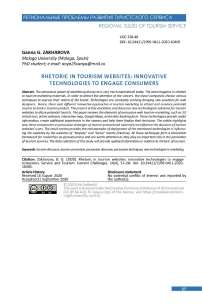Rhetoric in tourism websites: innovative technologies to engage consumers
Автор: Zakharova Ganna G.
Журнал: Современные проблемы сервиса и туризма @spst
Рубрика: Региональные проблемы развития туристского сервиса
Статья в выпуске: 4 т.14, 2020 года.
Бесплатный доступ
The persuasive power of advertising discourse is very much experienced today. The same happens in relation to tourism marketing materials. In order to attract the attention of the viewers, the travel companies choose various techniques to express their notion of the brand. Technologies are constantly evolving bringing new solutions for web designers. Hence, there exist different innovative approaches in tourism marketing to attract and convince potential tourists to book a tourism product. The present article elucidates and discusses new technological solutions for tourism websites to allure potential tourists. The paper reviews the elements of persuasive web tourism marketing, such as 3D virtual tour, online webcam, interactive map, Google Maps, and online booking form. These technologies provide useful information, create additional experiences in the viewers and help them finalize their decisions. The article highlights how these components as persuasive strategies of tourism promotional materials can influence the decisions of tourism websites’ users. The result section provides the real examples of deployment of the mentioned technologies in influencing the audience by the websites of “Karpaty” and “Solva” resorts (Ukraine). All these techniques form a theoretical framework for researches on persuasiveness and are worth attention as they play an important role in the promotion of tourism services. The data collection of this study will provide updated information in relation to rhetoric of tourism.
Tourism discourse, tourism promotion, persuasive discourse, persuasive techniques, new technologies in marketing
Короткий адрес: https://sciup.org/140249899
IDR: 140249899 | УДК: 338.48 | DOI: 10.24411/1995-0411-2020-10405
Список литературы Rhetoric in tourism websites: innovative technologies to engage consumers
- Cappelli, G. (2006). Sun, Sea, Sex and the Unspoilt Countryside. How the English language makes tourists out of readers. Pari: Pari Publishing.
- Crisan, R. E., Bolyai, B., & Cantemir, D. (2013). Tourism destination slogans - persuasive or manipulative? Editura Universităţii "Petru Maior". Pp. 943-948.
- Echtner, C., & Prasad, P. (2003). The Context of Third World Tourism Marketing. Annals of Tourism Research, 30, 660-682.
- Gotti, M. (2006). The Language of Tourism as Specialized Discourse. In: O. Palusci & S. Francesconi (Eds.) Translating Tourism. Linguistic/cultural representations, 15-34. Editrice Università degli Studi di Trento, Trento.
- Jack, G., & Phipps A. (2005). Tourism and Intercultural Exchange: Why Tourism Matters. Channel View Publications.
- Jorgensen, L. G. (2004). An analysis of a destination's image and the language of tourism. The Aarhus School of Business.
- Kim, H., & Fesenmaier, D. R. (2008). Persuasive design of destination web sites: An analysis of first impression. Journal of Travel Research, 47(1), 3-13.
- Maci, S. (2013). Tourism discourse: Professional, promotional and digital voices. ECIG, Genova.
- Morgan, N., & Pritchard, A. (2000). Advertising in tourism and leisure. Butterworth-Heinemann Publications, Oxford.
- Salim, M. A. B., Ibrahim, N. A., & Hassan, H. (2012). Language for tourism: A review of literature. Procedia-Social and Behavioural Sciences, 62, 136-143.


